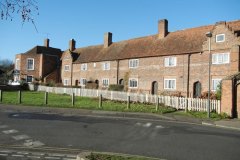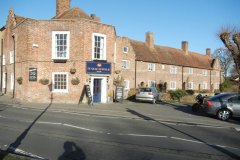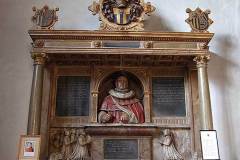Senior judge, MP and philanthropist
Roger Manwood was born in Sandwich. He studied law and was admitted to the Inner Temple in 1548. He became an MP for Hastings in 1555 and later for Sandwich, until appointed as an Assize judge in 1567. His career flourished and in 1563 he was granted the large estate of Hackington by Queen Elizabeth I. In 1578 he was appointed Chief Baron of the Exchequer, amongst the most powerful and influential judges in England. A man of his times, he often resorted to bribery and corruption to advance his own interests but had a profound commitment to common law. He imposed harsh punishments where he felt they were needed (including cutting out of the tongue for disloyalty to the Queen and fines for non-attendance at church) but was a generous benefactor to local causes.
His life touched on local affairs in many ways:
- His home at Hackington, now known as St Stephens, was by far the largest private residence in or near the city, and he became the wealthiest local private individual. The house, between the church and the almshouses, was demolished in about 1770.
- Manwood’s almshouses (Image 1) on St Stephen’s Green were built in the 1570s and endowed in his will. Each of the six residents enjoyed one meal a week in Manwood’s own house. The larger house at the end of the almshouse row, intended as a home for the warden, now serves as Ye Olde Beverlie public house (Image 2).
- Manwood’s imposing memorial (Image 3) in St Stephen’s church was designed by Maximilian Colte who later designed the famous tomb of Queen Elizabeth I in Westminster Abbey. The snakes either side of his head, and his firm grasp on a money bag, chime well with his life on earth. Around his neck hangs a chain known by scholars as the “SS collar” as has the effigy of Henry IV in Canterbury Cathedral; several learned writers have commented on its meaning since very few were allowed to wear it. The tomb also depicts Manwood’s wives and children, and incorporates a wooden skeleton claimed to be the most realistic in the county.
- Perhaps his greatest legacy was the founding and endowment of the Sir Roger Manwood school in Sandwich, now a 900 pupil non-denominational Foundation co-educational grammar school.
- One bequest of £20 in his will for the local poor was adopted in 1593 for the relief of those afflicted by the plague – including payments to watchers who made sure no one left the infected houses!
Sources: Oxford Dictionary of National Biography, Cox (1905), Crampton (2010), Foss (1858), Lyle (2005)
AT



